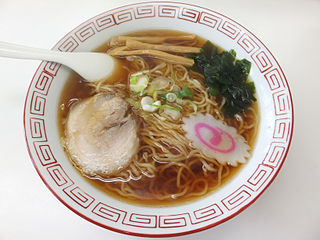
Japanese cuisine encompasses the regional and traditional foods of Japan, which have developed through centuries of political, economic, and social changes. The traditional cuisine of Japan is based on rice with miso soup and other dishes with an emphasis on seasonal ingredients. Side dishes often consist of fish, pickled vegetables, and vegetables cooked in broth. Common seafood is often grilled, but it is also sometimes served raw as sashimi or as sushi. Seafood and vegetables are also deep-fried in a light batter, as tempura. Apart from rice, a staple includes noodles, such as soba and udon. Japan also has many simmered dishes, such as fish products in broth called oden, or beef in sukiyaki and nikujaga.

Ramen is a Japanese noodle dish. It consists of Chinese-style wheat noodles served in a broth; common flavors are soy sauce and miso, with typical toppings including sliced pork, nori, menma, and scallions. Ramen has its roots in Chinese noodle dishes and is a part of Japanese Chinese cuisine. Nearly every region in Japan has its own variation of ramen, such as the tonkotsu ramen of Kyushu and the miso ramen of Hokkaido.

Soba are Japanese noodles made primarily from buckwheat flour, with a small amount of wheat flour mixed in. It has an ashen brown color, and a slightly grainy texture. The noodles are served either chilled with a dipping sauce, or hot in a noodle soup. They are used in a wide variety of dishes.

Saimin is a noodle soup dish common in the contemporary cuisine of Hawaii. Traditionally consisting of soft wheat egg noodles served in a hot dashi garnished with diced green onions and a thin slice of kamaboko, modern versions of saimin include additional toppings such as char siu, sliced Spam, sliced egg, bok choy, mushrooms, or shredded nori. When Chinese dumplings are added to the noodle soup, it is seen on menus as the heartier wonton min. All saimin establishments have their own, often secret recipe for the soup base, but primarily use kombu and dried shrimp as major ingredients. Common table condiments mixed in the saimin broth are Chinese hot mustard and soy sauce, added in small quantities according to each individual's taste. Many local residents of Hawaii also enjoy barbecued teriyaki beef sticks (skewers) or American hamburgers as a side dish.

Noodles are a staple of Japanese cuisine. They are often served chilled with dipping sauces, or in soups or hot dishes. Noodles were introduced to Japan from China during the Song Dynasty between the Heian until the early Kamakura period.

Okinawa soba (沖縄そば) is a type of noodle produced in Okinawa Prefecture, Japan. Okinawa soba is a regional collective trademark of The Okinawa Noodle Manufacturing Co-op. On Okinawa, it is sometimes simply called soba, although this Japanese term typically refers to buckwheat noodles in mainland Japan. The noodles of Okinawa soba are made from wheat flour, and do not contain any buckwheat.

Japanese Chinese cuisine, also known as chūka, represents a unique fusion of Japanese and Chinese culinary traditions that have evolved over the late 19th century and more recent times. This style, served predominantly by Chinese restaurants in Japan, stands distinct from the "authentic Chinese food" found in areas such as Yokohama Chinatown. Despite this difference, the cuisine retains strong influences from various Chinese culinary styles, as seen in the shippoku cooking style.

David Chang is an American restaurateur, author, podcaster, and television personality. He is the founder of the Momofuku restaurant group. In 2009, Momofuku Ko was awarded two Michelin stars, which the restaurant has retained each year since. In 2011, he co-founded the influential food magazine Lucky Peach, which lasted for 25 quarterly volumes into 2017. In 2018, Chang created, produced, and starred in a Netflix original series called Ugly Delicious, and through his Majordomo Media group, he has produced and/or starred in more television and podcasts. On November 29, 2020, he became the first celebrity to win the $1,000,000 top prize for his charity, Southern Smoke Foundation, and the fourteenth overall million dollar winner on Who Wants to Be a Millionaire, with the help of Mina Kimes via the phone-a-friend lifeline on the million-dollar question and Alan Yang as his supporter.

Ippudo, also known as Hakata Ippūdō (博多一風堂) in Japan, is a Japanese ramen restaurant chain with locations worldwide. Ippudo is well known for its tonkotsu ramen, and has been described as "the most famous tonkotsu ramen shop in the country".

Momofuku is a culinary brand established by chef David Chang in 2004 with the opening of Momofuku Noodle Bar. It includes restaurants in New York City, Toronto (defunct), Las Vegas, and Los Angeles, a bakery established by pastry chef Christina Tosi, a bar (Nikai), and a quarterly magazine.

Ramen Street is an area in the underground mall of the Tokyo Station railway station's Yaesu side that has eight restaurants specializing in ramen dishes. Some of the restaurants at Ramen Street include Rokurinsha, which specializes in tsukemen, Kanisenmon Keisuke, specializing in crab ramen dishes, and Nidaime Keisuke Ebi Soba Gaiden, specializing in prawn ramen dishes.

Muteppou Co., Ltd. is a Japanese ramen noodle restaurant chain headquartered in Kizugawa, Kyoto, Japan.

Tsukemen is a ramen dish in Japanese cuisine consisting of noodles that are eaten after being dipped in a separate bowl of soup or broth. The dish was invented in 1961 by Kazuo Yamagishi, a restaurateur in Tokyo, Japan. Since then, the dish has become popular throughout Japan, as well as overseas in the United States.
Marukin Ramen is a Tokyo-based chain of ramen restaurants.

Hapa PDX is a restaurant in Portland, Oregon.

Jeju Noodle Bar is a Korean restaurant in New York City. The restaurant has received a Michelin star.














